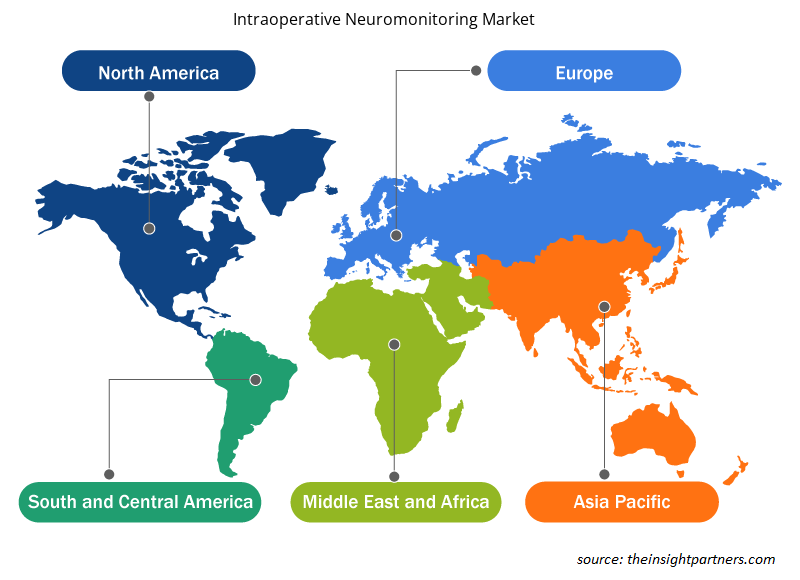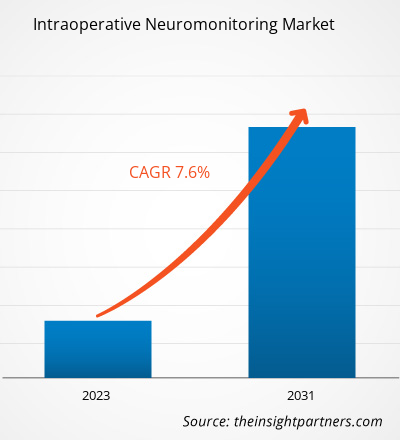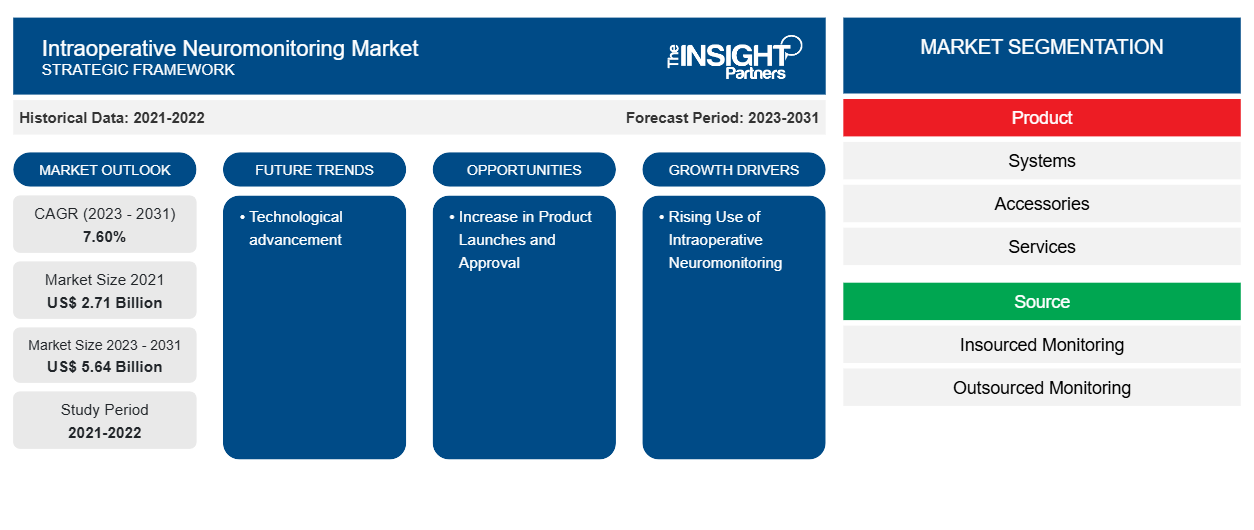بلغت قيمة سوق مراقبة الأعصاب أثناء الجراحة 2.71 مليار دولار أمريكي في عام 2021 ومن المتوقع أن تصل إلى 5.64 مليار دولار أمريكي بحلول عام 2031. ومن المتوقع أن يسجل السوق معدل نمو سنوي مركب بنسبة 7.60٪ في الفترة 2023-2031. ومن المرجح أن يظل التقدم التكنولوجي من الاتجاهات الرئيسية في سوق مراقبة الأعصاب أثناء الجراحة.
تحليل سوق مراقبة الأعصاب أثناء الجراحة
إن سائقي مراقبة الأعصاب أثناء الجراحة (IONM) هم مقدمو الرعاية الصحية المسؤولون عن إجراء وتفسير مراقبة الأعصاب أثناء العمليات الجراحية. وعادةً ما يكون هؤلاء الأفراد من علماء وظائف الأعصاب أو الفنيين المدربين تدريبًا عاليًا والذين يستخدمون تقنيات مراقبة مختلفة لتقييم سلامة وظائف الجهاز العصبي في الوقت الفعلي. كان التطور التكنولوجي المستمر يعمل على تحسين قدرات أنظمة IONM، مما يسمح بمراقبة أكثر دقة وفي الوقت الفعلي أثناء العمليات الجراحية. كان استخدام IONM ينمو بين الجراحين وغيرهم من المتخصصين الطبيين. بالإضافة إلى تحسين سلامة المريض، يقلل IONM من خطر تلف الأعصاب من خلال المساعدة في مراقبة الجهاز العصبي في الوقت الفعلي أثناء العمليات الجراحية. لتحسين النتائج والحد من المشكلات بعد الجراحة، يستخدم الجراحون IONM لتحديد وعلاج المضاعفات الجراحية المحتملة، مثل ضغط العصب أو تلفه. تزداد الحاجة إلى خدمات IONM لتعزيز سلامة المريض أثناء الإجراءات المعقدة مع إجراء المزيد من العمليات الجراحية. يؤدي المزيد من العمليات الجراحية إلى زيادة استخدام IONM، وخاصة تلك التي تنطوي على هياكل عصبية دقيقة. باختصار، يؤثر ارتفاع عدد الإجراءات الطبية على مراقبة الأعصاب أثناء العمليات الجراحية، مما يؤدي إلى دفع عجلة التقدم، وتنمية القوى العاملة، وتسليط الضوء على أهمية دمج مراقبة الأعصاب في الإجراءات الجراحية الروتينية.
نظرة عامة على سوق مراقبة الأعصاب أثناء الجراحة
يعد علم الأعصاب الموجه بالرنين المغناطيسي أحد أسرع المجالات الفرعية نموًا في علم الأعصاب، ويستخدم تقنية الفيزيولوجيا الكهربية لتحديد الهياكل العصبية التي تتطلب الحماية أثناء العمليات الجراحية العصبية ورؤية ما يحدث في جميع أنحاء الجسم. بشكل عام، تُستخدم تسجيلات الإمكانات الكهربائية المتدفقة عبر الجهاز العصبي أثناء الجراحة لمراقبة ورسم خرائط الإشارات الكهربائية في الجسم من خلال علم الأعصاب الموجه بالرنين المغناطيسي بالرنين المغناطيسي. يستخدم علم الأعصاب الموجه بالرنين المغناطيسي تقنيات مختلفة، يتم اختيار كل منها لاستخدامات خاصة للغاية. علاوة على ذلك، يمكن استخدام العديد من الوسائل في نفس الجراحة، اعتمادًا على الإجراء المحدد. يمكن استخدام تخطيط كهربية الدماغ (EEG)، والإمكانات المستحثة الحسية الجسدية (SSEPs)، والإمكانات المستحثة بصريًا (VEPs)، والإمكانات المستحثة سمعيًا في جذع الدماغ (BAEPs)، والإمكانات المستحثة حركيًا (MEPs)، وتخطيط كهربية العضلات، وتقنيات أخرى. يمكن للمرضى الذين يخضعون لمجموعة واسعة من جراحات الجهاز العصبي المركزي، مثل الإجراءات الإشعاعية التداخلية، وتصحيح العمود الفقري العظمي، وجراحة الصرع، وجراحة الأعصاب الوجهية والجمجمة ، الاستفادة من هذه التقنيات. وعلى الرغم من أنه يمكن تطبيقها على مجالات أخرى مثل جراحة الأوعية الدموية والغدد الصماء، إلا أنها تُستخدم غالبًا في جراحة العمود الفقري والصرع وأورام المخ وجراحة الأوعية الدموية الدماغية.
قم بتخصيص هذا التقرير ليناسب متطلباتك
ستحصل على تخصيص لأي تقرير - مجانًا - بما في ذلك أجزاء من هذا التقرير، أو تحليل على مستوى الدولة، وحزمة بيانات Excel، بالإضافة إلى الاستفادة من العروض والخصومات الرائعة للشركات الناشئة والجامعات
-
احصل على أهم اتجاهات السوق الرئيسية لهذا التقرير.ستتضمن هذه العينة المجانية تحليلاً للبيانات، بدءًا من اتجاهات السوق وحتى التقديرات والتوقعات.
محركات وفرص سوق مراقبة الأعصاب أثناء الجراحة
الاستخدام المتزايد لتقنية مراقبة الأعصاب أثناء الجراحة لصالح السوق
تعمل تقنية رسم الخرائط الأيونية والجراحة المجهرية (IONM) على تعزيز سلامة المرضى من خلال مساعدة الجراحين على تجنب تلف الهياكل الدماغية الحرجة والحد من خطر حدوث مضاعفات أثناء العمليات من خلال تزويدهم بملاحظات في الوقت الفعلي. أثناء العمليات، وخاصة تلك التي تنطوي على القرب من الأعصاب الحيوية، يمكن للجراحين تحقيق الملاحة الدقيقة من خلال استخدام تقنية رسم الخرائط الأيونية والجراحة المجهرية لمراقبة السلامة الوظيفية للجهاز العصبي. تساعد تقنية رسم الخرائط الأيونية والجراحة المجهرية في الكشف المبكر عن المشكلات المحتملة من خلال تقليل خطر حدوث مضاعفات مثل تلف الأعصاب أو الشلل أو فقدان الحواس أثناء الجراحة وبعدها. يؤكد الجمع بين هذه العوامل على أهمية مراقبة الأعصاب أثناء الجراحة في البيئات الجراحية الحديثة، مما يعزز اعتمادها كممارسة قياسية في العديد من الإجراءات.
زيادة في إطلاق المنتجات والموافقة عليها – فرصة في سوق مراقبة الأعصاب أثناء الجراحة
بسبب الطلب العالمي المتزايد من عدد كبير من السكان، يتوسع قطاع الرعاية الصحية باستمرار، مما يزيد من تطوير المنتجات الجديدة وإطلاقها والموافقات عليها. كما يستثمر كبار اللاعبين في السوق في البحث والتطوير للتعهد بالابتكار وإنشاء منتجات فعالة. على سبيل المثال، في أكتوبر 2023، كانت الميزة الثورية لنظام مراقبة الأعصاب أثناء الجراحة Neuromaster G1 (IONM) هي حل One View، الذي قدمته Nihon Kohden، الشركة المصنعة العالمية الرائدة للمعدات الإلكترونية الطبية. يتيح هذا النهج الجديد لبرنامج IONM دمج البيانات العصبية بسلاسة مع العلامات الحيوية للمريض، مثل معدل ضربات القلب، وSpO2، ودرجة الحرارة، والمزيد، مع الحفاظ على تخدير المريض.
تقرير تحليل تجزئة سوق مراقبة الأعصاب أثناء الجراحة
إن القطاعات الرئيسية التي تساهم في اشتقاق تحليل سوق مراقبة الأعصاب أثناء الجراحة هي المنتج والمصدر والتطبيق والطريقة والمستخدم النهائي.
- بناءً على المنتج، ينقسم سوق مراقبة الأعصاب أثناء الجراحة إلى أنظمة وملحقات وخدمات. احتل قطاع الأنظمة حصة سوقية أكبر في عام 2023.
- حسب المصدر، يتم تقسيم السوق إلى مراقبة داخلية، ومراقبة خارجية.
- من حيث التطبيق، يتم تقسيم السوق إلى جراحة العمود الفقري، وجراحة الأعصاب، وجراحة الأوعية الدموية، وجراحة الأنف والأذن والحنجرة، وجراحة العظام، والجراحات الأخرى.
- حسب النمط، يتم تقسيم السوق إلى إمكانات حركية مثارية، وإمكانات حسية جسدية مثارية، وتخطيط كهربية الدماغ، وتخطيط كهربية العضلات، وإمكانات سمعية مثارية من جذع الدماغ، وإمكانات بصرية مثارية.
- وفقًا للمستخدم النهائي، يتم تصنيف سوق مراقبة الأعصاب أثناء الجراحة إلى المستشفيات ومراكز الجراحة الخارجية.
تحليل حصة سوق مراقبة الأعصاب أثناء الجراحة حسب المنطقة الجغرافية
ينقسم النطاق الجغرافي لتقرير سوق مراقبة الأعصاب أثناء الجراحة إلى خمس مناطق: أمريكا الشمالية، ومنطقة آسيا والمحيط الهادئ، وأوروبا، والشرق الأوسط وأفريقيا، وأمريكا الجنوبية/أمريكا الجنوبية والوسطى.
سيطرت أمريكا الشمالية على سوق مراقبة الأعصاب أثناء الجراحة. في أمريكا الشمالية، تعد الولايات المتحدة أكبر سوق لمراقبة الأعصاب أثناء الجراحة في عام 2023. علاوة على ذلك، من المتوقع أن تنمو منطقة آسيا والمحيط الهادئ بأعلى معدل نمو سنوي مركب في السنوات القادمة. أصبحت IONM تحظى بشعبية متزايدة في منطقة آسيا والمحيط الهادئ بسبب الوعي المتزايد والتقدم في التكنولوجيا وزيادة الإجراءات الجراحية. إن الطلب المتزايد على حلول الرعاية الصحية المتطورة وفهم مزايا مراقبة الأعصاب أثناء العمليات الجراحية يدفعان نمو سوق IONM في منطقة آسيا والمحيط الهادئ. تبنت المستشفيات والمرافق الصحية الكبرى في منطقة آسيا والمحيط الهادئ IONM كإجراء قياسي للجراحات المعقدة لتحسين سلامة المرضى. يستخدم IONM على نطاق واسع في جراحات العظام والعمود الفقري في منطقة آسيا والمحيط الهادئ، حيث توجد حاجة كبيرة لمراقبة الهياكل العصبية أثناء هذه الإجراءات.
رؤى إقليمية حول سوق مراقبة الأعصاب أثناء الجراحة
لقد قام المحللون في Insight Partners بشرح الاتجاهات والعوامل الإقليمية المؤثرة على سوق مراقبة الأعصاب أثناء الجراحة طوال فترة التوقعات بشكل شامل. يناقش هذا القسم أيضًا قطاعات سوق مراقبة الأعصاب أثناء الجراحة والجغرافيا في جميع أنحاء أمريكا الشمالية وأوروبا ومنطقة آسيا والمحيط الهادئ والشرق الأوسط وأفريقيا وأمريكا الجنوبية والوسطى.

- احصل على البيانات الإقليمية المحددة لسوق مراقبة الأعصاب أثناء الجراحة
نطاق تقرير سوق مراقبة الأعصاب أثناء الجراحة
| سمة التقرير | تفاصيل |
|---|---|
| حجم السوق في عام 2021 | 2.71 مليار دولار أمريكي |
| حجم السوق بحلول عام 2031 | 5.64 مليار دولار أمريكي |
| معدل النمو السنوي المركب العالمي (2023 - 2031) | 7.60% |
| البيانات التاريخية | 2021-2022 |
| فترة التنبؤ | 2023-2031 |
| القطاعات المغطاة |
حسب المنتج
|
| المناطق والدول المغطاة |
أمريكا الشمالية
|
| قادة السوق وملفات تعريف الشركات الرئيسية |
|
كثافة اللاعبين في سوق مراقبة الأعصاب أثناء الجراحة: فهم تأثيرها على ديناميكيات الأعمال
يشهد سوق مراقبة الأعصاب أثناء الجراحة نموًا سريعًا، مدفوعًا بالطلب المتزايد من المستخدم النهائي بسبب عوامل مثل تفضيلات المستهلك المتطورة والتقدم التكنولوجي والوعي المتزايد بفوائد المنتج. ومع ارتفاع الطلب، تعمل الشركات على توسيع عروضها والابتكار لتلبية احتياجات المستهلكين والاستفادة من الاتجاهات الناشئة، مما يؤدي إلى زيادة نمو السوق.
تشير كثافة اللاعبين في السوق إلى توزيع الشركات أو المؤسسات العاملة في سوق أو صناعة معينة. وهي تشير إلى عدد المنافسين (اللاعبين في السوق) الموجودين في مساحة سوق معينة نسبة إلى حجمها أو قيمتها السوقية الإجمالية.
الشركات الرئيسية العاملة في سوق مراقبة الأعصاب أثناء الجراحة هي:
- ميدترونيك
- نيوروسوفت
- شركة نيهون كوهدن
- شركة إنترانيرف للعلوم العصبية القابضة، ذ.م.م.
- شركة نيوفاسيف
- منتجات نيوروفيجن الطبية
إخلاء المسؤولية : الشركات المذكورة أعلاه ليست مرتبة بأي ترتيب معين.

- احصل على نظرة عامة على أهم اللاعبين الرئيسيين في سوق مراقبة الأعصاب أثناء الجراحة
أخبار السوق والتطورات الأخيرة في مجال مراقبة الأعصاب أثناء الجراحة
يتم تقييم سوق مراقبة الأعصاب أثناء الجراحة من خلال جمع البيانات النوعية والكمية بعد البحث الأولي والثانوي، والتي تتضمن منشورات الشركات المهمة وبيانات الجمعيات وقواعد البيانات. فيما يلي قائمة بالتطورات في سوق مراقبة الأعصاب أثناء الجراحة والاستراتيجيات:
- أعلنت شركة MPOWERHealth، الرائدة في مجال مراقبة الأعصاب أثناء الجراحة (IONM)، عن الاستحواذ الاستراتيجي على عمليات Assure Neuromonitoring في الأسواق المحورية، مما يمثل خطوة مهمة في توسيع خدمات مراقبة الأعصاب أثناء الجراحة (IONM) الأفضل في فئتها. يعزز الاستحواذ المستهدف تغطية MPOWERHealth للمرضى إلى أكثر من 55000 مريض سنويًا، مما يعزز دورها كشركة رائدة في تعزيز السلامة الجراحية ونتائج المرضى (المصدر: اسم شركة MPOWERHealth، النشرة الإخبارية، 2024)
- أعلنت شركة Brainlab، وهي شركة متخصصة في تكنولوجيا الطب الرقمي، عن استحواذها على شركة Dr. Langer Medical GmbH. وتتخصص الشركة العائلية التي يقع مقرها في فالدكريش بألمانيا في تطوير حلول مراقبة الأعصاب أثناء الجراحة والمعدات ذات الصلة بالتدخلات الجراحية. (المصدر: اسم شركة Brainlab AG، بيان صحفي، 2022)
تقرير سوق مراقبة الأعصاب أثناء الجراحة والتغطية والنتائج
يوفر تقرير "حجم سوق مراقبة الأعصاب أثناء الجراحة والتوقعات (2021-2031)" تحليلاً مفصلاً للسوق يغطي المجالات التالية:
- حجم السوق والتوقعات على المستويات العالمية والإقليمية والوطنية لجميع قطاعات السوق الرئيسية التي يغطيها النطاق
- ديناميكيات السوق مثل المحركات والقيود والفرص الرئيسية
- الاتجاهات المستقبلية الرئيسية
- تحليل مفصل لقوى PEST/Porter الخمس وSWOT
- تحليل السوق العالمي والإقليمي الذي يغطي اتجاهات السوق الرئيسية واللاعبين الرئيسيين واللوائح والتطورات الأخيرة في السوق
- تحليل المشهد الصناعي والمنافسة الذي يغطي تركيز السوق، وتحليل خريطة الحرارة، واللاعبين البارزين، والتطورات الأخيرة
- ملفات تعريف الشركة التفصيلية
- التحليل التاريخي (سنتان)، سنة الأساس، التوقعات (7 سنوات) مع معدل النمو السنوي المركب
- تحليل PEST و SWOT
- حجم السوق والقيمة / الحجم - عالمي، إقليمي، بلد
- الصناعة والمنافسة
- مجموعة بيانات إكسل
التقارير الحديثة
شهادات العملاء
سبب الشراء
- اتخاذ قرارات مدروسة
- فهم ديناميكيات السوق
- تحليل المنافسة
- رؤى العملاء
- توقعات السوق
- تخفيف المخاطر
- التخطيط الاستراتيجي
- مبررات الاستثمار
- تحديد الأسواق الناشئة
- تحسين استراتيجيات التسويق
- تعزيز الكفاءة التشغيلية
- مواكبة التوجهات التنظيمية























 احصل على عينة مجانية ل - سوق مراقبة الأعصاب أثناء الجراحة
احصل على عينة مجانية ل - سوق مراقبة الأعصاب أثناء الجراحة